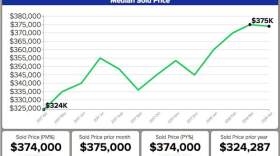The median sales price of a single-family home in Reno is now higher than it was during the peak of the housing boom just before the Great Recession.
This surge in pricing is reminding many in the region of the thriving market of the mid-2000s, as well as the devastation the ensuing crash caused to Northern Nevada.
So, how similar is our situation now compared to before?
Reno Public Radio’s Noah Glick explores that question.
Let’s jump in the time machine and head back to 2005. Kanye West was topping the charts and Kenny Guinn was governor.
Nevada’s economy was the second-fastest growing in the country. The median price for a single-family home in Reno was $350,000. Unemployment was low, at 4.1 percent. And housing was hard to come by, with available inventory far below demand.
Stop me if this sounds familiar.
“Heading into the recession, homes were often being bought and then sold immediately,” says David Schmidt. He’s the chief economist for the state Department of Employment, Training and Rehabilitation.
“You have people lining up to buy homes that are coming out of new housing developments simply to have the opportunity to go and resell that home a short time later and make a profit,” Schmidt says.
The demand now is less tied to profit opportunities and more tied to a true need, says Mike Kazmierski, the president of the Economic Development Authority of Western Nevada.
“The demand is real. It’s not financial crisis imaginary,” he says. “It’s a real demand, people moving here that need housing that have great jobs.”
So far, Nevada has been unable to keep up with the influx of thousands of new workers who need someplace to live. Kazmierski says part of that is due to a shortage in construction labor, as workers left the region during the Great Recession to find work elsewhere.
“We totally shut down housing construction. And the scary part about that is that we were building around 5,000 housing units a year on average: apartments, condos, and single family,” he says. “And we had a lot fewer people in the community then than we do now. Yet, since the recession, six years on, we’ve averaged less than 3,000.”
In 2005, construction made up more than 11 percent of the workforce in the state. Now it’s roughly 6 percent with a loss of 56,000 workers.
Fewer construction crews are leading to higher housing costs today.

And then there’s financing. People had much easier access to home loans in 2005 than they do now.
Brian Cushing is the senior loan officer at Guild Mortgage in Reno. He says before the Great Recession, there were a dozen types of home loans for consumers—many of which, in hindsight, were not financially prudent.
“There was different types of loans that had interest only features, where you only had to pay the interest. There were other loans that have a negative amortization. You’d actually pay less than you owed on interest every month,” Cushing says.
“There was other ones that we considered stated income. So, instead of you giving me your tax return you could just state to me your income. The problem is you never had to double check that.”
Cushing says lenders wanted to make money and consumers wanted to get in on a hot market—without necessarily thinking long-term, like they do now.
“A lot of folks within the industry and within the consumer world just figured they would refinance it in a couple of years, no big deal. So, the change has mainly been the mindset is, ‘Get me set up on a loan now that I can keep for 30 years.’”
Lending regulations have tightened significantly with the Dodd-Frank Act, which added reforms to lending and consumer protections. Now, instead of a dozen loan programs, there are just a handful. And to qualify, you must show proof of stable income and a lower debt-to-income ratio than before.
Along with more prudent lending practices and higher construction costs, inventory remains a critical issue, and sellers can demand a higher price.
Heidi Kasama is the president of the Nevada Association of REALTORS®.
“We have sellers that are a little hesitant to sell, which would actually help us with our inventory,” she says. “But they don’t know where they’re going to go when they sell this home, because they’re worried they won’t be able to get a house to replace the one that they want to sell.”
Kasama says new lending regulations have created a more stable housing market. And economic officials say the region’s more diversified economy will help shield against catastrophe.
But until housing supply catches up with demand on the region, it’s unlikely Nevadans will find relief in the housing market anytime soon.
NMLS 3274, Guild Mortgage is an Equal Housing Lender; Brian Cushing NMLS 303045. Sound effects provided by freesfx.co.uk.







